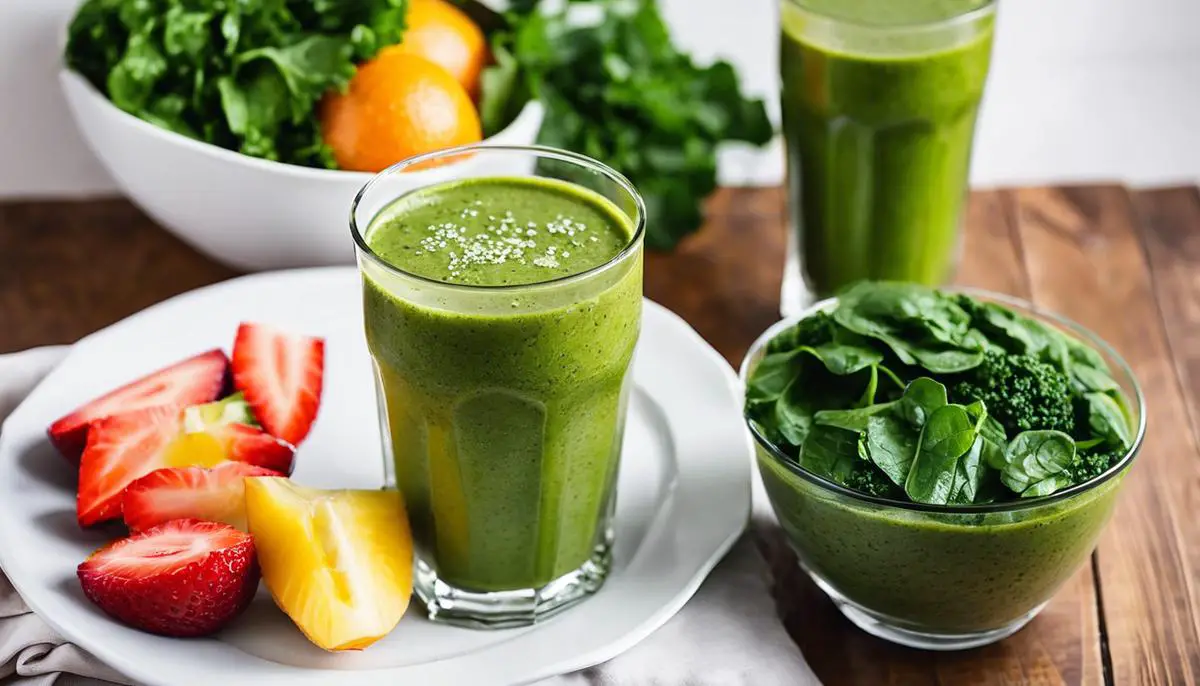Have you ever wondered about the calorie count in your favorite 16oz green smoothie? Let’s unwrap the mystery behind this popular health drink. Green smoothies are a trendy choice for anyone looking to boost their fruit and vegetable intake. They pack a punch, combining leafy greens with ripe fruits and other nutritious add-ins. By understanding the specifics of what goes into your smoothie, you can gauge how it fits with your dietary needs and lifestyle choices. Let’s sip through the facts and find out the benefits tucked inside every blended glass.
Table of Contents
Calorie Content in 16oz Green Smoothie
When considering the calorie content of a 16-ounce green smoothie, there are variable factors that come into play. Typically, a 16-ounce green smoothie can range between 100 to 350 calories, largely dependent on the specific ingredients selected. Green smoothies often incorporate leafy greens such as spinach or kale, combined with fruits like bananas, apples, or berries. The choice of a liquid base, which could be water, almond milk, or fruit juice, also affects the final caloric count.
The nutritional profile of a green smoothie can be quite impressive. Leafy greens contribute a wealth of vitamins and minerals, including Vitamin A, Vitamin C, calcium, and iron, all of which are important for maintaining good health. Fruits add essential dietary fiber and natural sweetness, reducing the need for additional sugars. If a liquid base like unsweetened almond milk is used, it can keep the calorie count lower while providing a creamy texture. By selecting whole-food ingredients and being mindful of natural sugar content, green smoothies can be a nutrient-dense, low-calorie option ideal for those seeking to manage weight, increase their intake of fruits and vegetables, and improve overall dietary habits.
Keep in mind that some smoothies can also include higher-calorie ingredients like nuts, seeds, or protein powders. These can offer additional benefits such as healthy fats and protein, but will increase the calorie count. Always consider the purpose of the smoothie – be it a light snack or a meal replacement – and tailor it to meet your nutritional needs while maintaining an appropriate calorie intake for your lifestyle.

Nutritional Value of Ingredients
Green smoothies, bursting with nutrients, often integrate an array of leafy greens like spinach and kale.
These greens are nutritional powerhouses, offering a rich supply of vitamins A, C, and K, essential minerals like iron and calcium, and packed with disease-fighting antioxidants.
Spinach particularly stands out for its folate content, paramount in red blood cell formation and crucial during pregnancy for fetal development.
Similarly, kale brings a wealth of nutrients to the blend, including fiber, which promotes digestive health, and vitamin C, paramount for immune defense and skin vitality.
Fruits, another staple in green smoothies, contribute natural sweetness along with a spectrum of vitamins and minerals.
Bananas, a popular choice, not only provide thickness but also a substantial dose of potassium, vital for heart and muscle function.
Berries, such as blueberries and strawberries, inject a burst of flavor and boast a high concentration of antioxidants like flavonoids, which reduce inflammation and may lower the risk of chronic diseases.
Apples and pears add texture and are replete with dietary fiber that aids in fullness and supports a healthy gut microbiome.
By mindfully selecting fruits low in calories and high in fiber, smoothie aficionados ensure their drink remains a beacon of wellness.

Impact of Preparation Methods
When considering green smoothies, the preparation method can significantly alter the calorie content of the final blend. Choosing different ingredients or altering the method can either increase or decrease the number of calories per serving, making it crucial for those conscious about their calorie intake to understand these effects.
The blending process itself does not change the calorie content of the ingredients; however, the types of ingredients added during the preparation can have a substantial impact. For example, adding nut butters, seeds, or avocados to a green smoothie increases the calorie count due to their higher fat content, despite their nutritional benefits. Conversely, sticking to strictly leafy greens, low-calorie fruits, and water or plant-based milks as the liquid base will maintain a lower calorie count.
Moreover, sweetening agents play a critical role in the calorie equation of a green smoothie. Natural sweeteners like honey or maple syrup, while providing a rich flavor profile, can significantly boost the calorie content. Artificial or zero-calorie sweeteners could be an alternative to keep the calorie count down, but it’s vital to consider their impact on the overall nutritional value and potential side effects.
Lastly, the size of the smoothie serving is a determining factor. Larger portions naturally mean more calories, so it’s important to serve an appropriate amount that aligns with the individual’s dietary goals. Customizing green smoothies by carefully selecting ingredients and understanding their caloric impact empowers individuals to create a beverage that aligns with their health objectives while enjoying the nutritional bounty of greens and fruits.

Calories and Weight Management
Incorporating a 16oz green smoothie into one’s diet, specifically for weight management purposes, can be a practical approach for those striving to balance busy lives with healthy eating habits. With a foundation of leafy greens complemented by a thoughtful selection of fruits, such a smoothie offers a convenient solution for meal replacement or a nutrient-packed snack.
As an effective tool for weight control, the green smoothie’s assets lie not only in its low-calorie makeup but also in its ability to satisfy hunger. The key to maximizing its benefits is in the proportion and choice of ingredients. Fiber-rich components such as kale and spinach contribute to a feeling of fullness, potentially curbing the urge to indulge in less healthy options. When paired with high-fiber fruits, these smoothies support digestive health while keeping calorie counts in check.
When blended properly, the raw ingredients in green smoothies retain most of their nutritional integrity, delivering a burst of enzymes, vitamins, and minerals that are sometimes lost during cooking. This efficiency in nutrient delivery provides the body with the tools it needs for energy conversion and metabolic support. To ensure that the green smoothie remains aligned with weight management goals, it’s critical to be mindful of the natural sugars in fruits, moderating portions to keep the overall energy density favorable. Such attention to composition reinforces the smoothie’s role as a positive contributor to a balanced eating plan.

Smoothies are more than just a quick meal; they’re a blend of nature’s finest offerings. A well-crafted 16oz green smoothie offers a refreshing way to consume essential nutrients and support your dietary goals. It’s vital to remember that the key to a healthful smoothie lies in the balance and quality of ingredients. Opt for whole fruits, fresh greens, and mindful add-ins. With these choices, your smoothie can be both a delight to your taste buds and a boon to your wellness journey. Cheers to your health with every vibrant, nourishing sip!

Tamara Tanasković Specialist Professional Nutritionist-Dietitian Expert in Public Health Nutrition
As an authoritative source in nutrition and dietetics, my website serves as a comprehensive educational platform. It offers in-depth insights into nutrition, covering diverse areas like dietetics, food technology, and specific nutritional needs during different life stages such as childhood, adolescence, pregnancy, and lactation. Additionally, I provide evidence-based clarifications on prevalent nutrition myths.
Visitors to the site can benefit from my expertise as a specialist professional nutritionist-dietitian through personal consultations or tailored nutrition plans designed to meet individual health goals.
Biography
Tamara Tanasković’s professional journey began with a foundational education at the Pharmaceutical-Physiotherapeutic School, where she specialized as a cosmetic technician and a physiotherapy technician. This multidisciplinary background laid the groundwork for her focused studies in nutrition and dietetics at the Higher School of Health Studies in Belgrade. Her advanced academic achievements earned her the title of a specialist nutritionist-dietitian, with a particular emphasis on public health.
I am the creator of the influential Instagram page @planishrane, dedicated to spreading knowledge about healthy eating habits, the importance of lifestyle choices, and the interplay between diet and various health conditions. My experience extends over several years in crafting personalized online meal plans, catering to both wellness-focused individuals and those with specific health conditions.
In collaboration with cosmetician Jelena Vještica, I co-authored four handbooks in January 2021. These guides delve into the relationship between diet and skin health, specifically addressing facial care and nutritional approaches to managing acne and related skin conditions.
My work and the impact of my website have garnered recognition from renowned entities like Prolom Water, Prolom Spa, Lukovska Spa, Just Superior, Jumbo, ABC, Fun&Fit, Piazza Organica, and more.
In line with my commitment to holistic health, I engage in the cultivation of organic herbs, vegetables, and fruits. My mission is to empower individuals with the knowledge and tools to make informed health choices throughout their lives, fostering a culture of wellness and informed dietary practices.
Embracing Healthy Eating for a Healthier Life!





